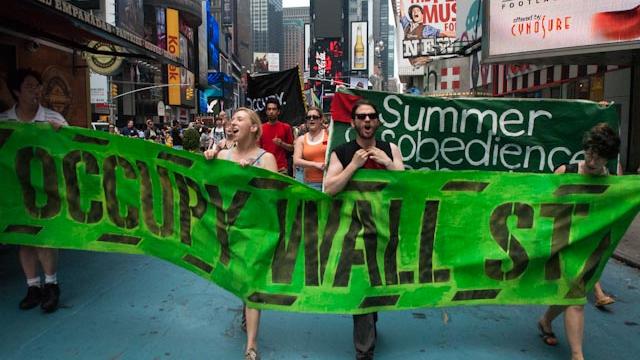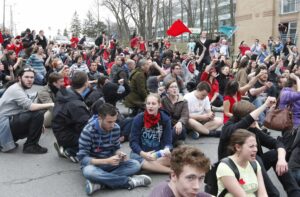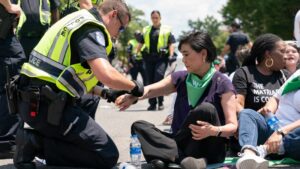
New York, NY–I skipped Summer Disobedience School last weekend to take a break from things, but was reigned in again with the program’s new location (the second of four): Central Park! Curious to see what sort of targets this location nested and what actions they would inspire, I strolled from the subway and around Columbus Circle to the park’s south-west corner, where we would be meeting.
As I approached the park I was a little confused as to where the SDS crew was. There were two reasons for this: first, this happened to be the day where a huge skating event was to take place, so the entrance to the park was clogged with a crowd of people and skateboards that was tough to navigate and see through. Second, I am of the rare breed of occupiers who makes every effort to arrive on time to an event, which means the group I sought was, at that moment, very, very small.
I found the handful of people waiting for Summer Disobedience School to begin, and was glad to be one of the first there, as there were a few familiar faces who I haven’t yet had the chance to sit down and talk to. But this quiet moment as we awaited more to come finally provided the opportunity to get to know others and discuss things in an unstructured environment, free of any goal or consensus-seeking. The popular topic among us was the ongoing trial for those accused of trespassing in Duarte Square on December 17 and facing possible jail time. Everyone traded the latest gossip they’d heard from the trial and shared their own stories of ridiculous arrests, or questionable arrests of others that they’ve witnessed recently.
Eventually, we had a nice-sized group going. Now running maybe an hour late, we did a very short and quick practice of melting, linking arms and hup-hup-hupping before hearing what today’s action would be: we would use the space to our advantage, using one of its attractions as a symbol for the thing we wanted to raise awareness of: hydro-fracking. We would march to the fountain at Bethesda Terrace, focusing on outreach along the way, passing out hundreds of flyers and shaking maracas. We did not want to appear angry today; instead, we would be jubilant and inviting.
So why the fountain at Bethesda Terrace? We learned that the fountain was built to celebrate the completion of the Croton Aqueduct , which brought into New York City some of the finest drinking water in the country that we continue to enjoy today—whereas beforehand the poor were reliant on wells that contained contaminated water and spread cholera. But with hydro-fracking the Marcellus Shale, New York once again runs the risk with dirty water, as evidenced by those in other communities who have been able to ignite their tap water.
On our small march, some of us carried maracas, some had flags, bright blue balloons to symbolize drops of water, and most of us carried flyers to pass out to spectators that we passed. The people at Central Park were very receptive; they were overall happy to take our flyers that explained the dangers of hydro-fracking, and those riding by on their bikes often raised their hands in support as we passed. We received the best response from the group of skaters close to where we began, who roared in unison when someone called out “Occupy Wall Street loves skaters! Join us!” While we wanted to both spread awareness and get people to join in on the march, we were unable to pick up new participants. There was also a very minimal police presence; I only saw some park rangers, and there was no conflict whatsoever with authorities.
When we approached the fountain, we marched under the terrace and chanted “Frack Wall Street, not our water!” which echoed nicely from within the hall’s darkness and demanded the attention of all those around. We walked to the pond behind the fountain and formed a wall, where we mike checked this statement explaining why we were there:
This beautiful space is called Bethesda Terrace. Its centerpiece is the Angel of the Waters Fountain. It celebrates the completion of the Croton Aqueduct in 1842.
Before the Aqueduct was built, most New Yorkers had no reliable source of clean, safe water. Rich New Yorkers could afford to buy water, but poor New Yorkers shared common wells. Wells were often contaminated with sewage. Thousands of people died from the contaminated water.
Ever since the Croton Aqueduct was built, New York has had some of the best drinking water in the United States. Its sources are so pure that it doesn’t need treatment on its way to our homes.
Hydro-fracking may change that.
Hydro-fracking involves injecting millions of gallons of water and toxic chemicals underground to release trapped gas. This waste water, and the heavy metals and radioactive particles that are released in the process, can find their way to our ground and surface waters. Methane, a greenhouse gas 20 times worse than carbon dioxide, is also released in the process. This has led to residents near drilling sites being able to set their tap water on fire.
New York State wants to crack its portion of the Marcellus Shale, which is in the same region as our unfiltered watersheds. If a filtration plant is needed, it would cost us 10 billion dollars to build. Fracking is both economically and environmentally a complete disaster. Fracking places profits over people. Ban fracking and protect our remaining sources of clean water.
Utilizing the space concretely to get a message across was a smart tactic. You can imagine that many people at Central Park may be tourists, and opening with a brief history lesson on what it was they were enjoying around them seemed to be a great draw. But not just an interesting fact, it also brings attention to history, of promises made to us by our ancestors—in this case, clean drinking water—which, it’s becoming apparent, are our responsibilities to hold those in power accountable for.
We climbed the steps to the terrace—which was a moment of confusion, our group breaking formation, some far ahead of others and many not knowing that we intended to do a banner drop from the terrace. After our brief photo-op and the passing out of more flyers, we made a casual walk back to our starting point for debrief.
– Joe Sutton –
Photo by Julia Reinhart








